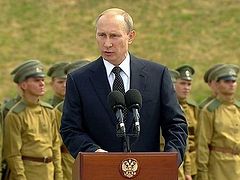 Курильские острова. Снимок из космоса Курильские острова. Снимок из космоса |
| Курильские острова. Снимок из космоса |
On the threshold of the current Russian-Japanese Summit talks Russian society follows every word of the leaders of Russia on so-called territorial problem with strained attention. So it did on November 14-15, 2004, when at first S. V. Lavrov, the Minister for Foreign Affairs and then the President himself confirmed “Russia’s allegiance to the commitments, arising from the Soviet-Japanese Declaration of 1956”.
Mass media hack writers rushed for comments to diplomats and politicians, deputies from the Committee for Foreign Affairs of the State Duma and leaders of political parties to clear up whether this recurrent declaration is an illustration of willingness “to hand over the administration” of Southern Kurils or “to return” them to Japan.
Thinking strictly negative about any transfer of any island to Japan, it’s necessary for the sake of justice to explain: the idea of the declaration of the President and the Minister isn’t originally new. It is a continuation of the tactics of the last several years; it’s clear enough for professionals. This tactics is as follows: not to deny all that was promised by previous authorities, to speak only about the allegiance to the Declaration of 1956, i.e. only about Habomai and Shikotan excluding Kunashir and Iturup (which become the subject of discussion in the middle of 1990s under the pressure of Japan) from the agenda; at last, to accompany the words about “allegiance...” by formulas that would especially disagree with Japanese official point of view.
The Declaration implied concluding of peace at first and after that the “transfer” of two islands. The transfer is a good will act and willingness to dispose of our own territory “meeting the wishes of Japan and taking into account the interests of the state of Japan”. But Japan insisted on the “return” before concluding of peace, because the use of the term “to return” means already an admission of illegality of the fact that these territories belong to Russia. It is a revision of not only the results of the World War II, but the principle of firmness of these results.
Our society would accept this tactics as appropriate at the period of lack of allies and resources to revise foreign-policy advances of 1990s, but it has bitter experience of Kozyrev’s foreign policy. The anxiety is quite understandable.
It’s useful to to remind again and again of historical and legal parameters of the problem that, in fact, arose in consequence of nihilism and lack of will of the first decade of perestroyka. And we are faced with estimating and feeling of this consequence.
***
The active balanced policy of Russia in the entire Asian-Pacific region, long-awaited return of multivector policy of Russia as a great Eurasian power has, in fact, impediments because of ambiguity in Russian-Japanese relations. But the hope of Japan to get Kuril Islands was the result of Russian policy of the beginning of 90s itself, when M. Gorbachev suddenly declared that the “territorial problem” had existed. This hope is cherished with open support of the USA, which has the most serious interests in Pacific region. And, concerning this problem, besides sharp weakening of Russian strategical positions, making concessions to Japan would be a precedent of extraordinary importance for changes in territorial status quo in Europe.
Destruction of the Yalta-Potsdam system and appearance of new states in Europe weren’t juridical revision of the territorial results of the World War II, that’s why all these dramatic for Russia events couldn’t cause automatic undermining of legitimacy of the post-war settlement of territorial problems. It would cause a different effect to satisfy all the claims of Japan to “return” the Islands that means to undermine the principle of indisputability of the results of the World War II. It would also give other states an opportunity to call in question other aspects of a territorial status quo.
Terms and concepts
However archaic this method seems to supporters of “globalization” and substitution of rights of nations and national interests by “human rights” and “interests of universal democracy”, the principle of indisputability of the results of the World War II - the basis of all post-war international relations keeps its fundamental importance; the term “to return” must be withdrawn from use of Russian officials. Because the use of this very term is nothing less than a conceptual revision of the results of WW II, meaning indirect recognition of new Japan as a continuer of its predecessor – the state of Japan that unleashed the war and surrendered without any condition.
It seems that even professionals, all the more newsdealers can’t realize that neither West and East Germany nor new united Germany (nor Japan) is a juridical successor to pre-war states; they don’t have continuity. They are new subjects of international relations and international law. Their succession to pre-war states was limited by decisions of the powers that had carried the quadrilateral responsibility. This arises from the legal interpretation of the principle of an unconditional surrender, the basis of the post-war political order.
An unconditional surrender differs in the main from a simple one; its results (legal, political and historical) are not the same at all. Surrender means the recognition of a defeat in military actions and doesn’t touch upon a question of continuance of being a subject of international law of a defeated power, whatever losses it sustained. A state keeps its sovereignty and being a subject of international law and carries on truce talks itself as a legally recognized party.
An unconditional surrender means termination of existence of a subject of international relations, “dismantling” previous state as a political institute; the state loses its sovereignty and all the powers; the powers-victors determinate conditions of peace, post-war order and settlement. A new subject of international law appears instead of a former one; it may have some continuance of being a subject of international law (limited by the powers-victors in a peace treaty or other juridical documents). But these subjects of international law differ from each other. Such new subjects were German Democratic Republic, Federal Republic of Germany and Japan. These new states were established under the conditions of the Allies; they had new borders, constitutions and bodies of the governments. It’s evident – Germany had even got a new name of the state. Either FRG or GDR hadn’t got full sovereignty even 40 years after the World War II. According to international law, their sovereignty had so-called derivative character because the Allies had kept their quadrilateral responsibility.
A juridical precedent of the use of the authorities of a keeper of the quadrilateral responsibility regarding FRG by the United States is demonstrated by the episode of Arab-Israeli war in 1973 when FRG officially declared its negative attitude to the use of its ports and airdromes by US Army to send armament to Israel. The Minister for Foreign Affairs of FRG W. Scheel declared that his country chose the role of a neutral power. Then US Department of State issued an official note which stated that FRG had no full sovereignty and that the United States had the right to use West German territory for any purpose if necessary without notifying (the right had followed the principles of the post-war settlement and treaties concluded on their basis). The default of full sovereignty was also demonstrated at the moment of the reunion of Germany. This process could hardly been stopped but the four powers-victors must formally decline all their authorities (according to “two plus four” Agreement) to give a new state full sovereignty.
In outward appearance, the display of Japanese sovereignty’s default is less evident. Japan retained its former emperor; this fact is used to state that the continuance of being the subject of international law of Japan hadn’t been interrupted and the continuity of imperial dynasty means the continuity of the former state. As a matter of fact, the source of retaining the power of the emperor is different – the victors’ will and decision. Japan could expect any outcome; therefore it inquired the Allies after retaining the power of the emperor on October 10, 1945, and the answer was positive (J. Byrnes, the Secretary of State of the United States especially pointed this to V. Molotov at the first session of the Conference of Ministers for Foreign Affairs on September 22, 1945). The position of Japan that read “Japan isn’t bound by Yalta agreements because it wasn’t a party at them” – this position is no good at all. Neither before nor after its reunion Germany tried to revise the most important principles of the post-war order that way. If the right of post-war Japan to dispute the victors’ territorial decisions would be recognized, there will be no guarantee of certainty of the Oder-Neisse Line traced not by Germany but by the powers-victors without asking field marshal Keitel’s consent. Present-day Japan is a post-war state; any settlement may proceed solely from the post-war international legal basis, especially as only this basis has the force of the law.
Some historical facts
All the historical treaties of the past Japanese politicians refer to had already lost their validity at all in 1904, when the Russian-Japanese war began, not in 1945. International law read that being at war means discontinuance of any agreements between the countries-enemies. Only considering this, all the “historical” argumentations of Japan bear no relation to the rights of present-day Japan. Japanese politicians especially refer to the agreements of XIX century – the Simodo Trade Agreement of 1855 (according to which the border was traced between Urup and Iturup islands; Sakhalin remained without any demarcation) and the St. Petersburg Agreement of 1875 (according to which all the Kuril Islands were transferred to Japan for recognition of Sakhalin being Russian). The fact itself that once upon a time a part of a country could belong to another country has no historical legal basis. In the process of forming the geographic-political image of the world a lot of territories of present-day countries belonged to other ones. As a result of the victory over Nazi Germany and its allies Kaliningrad (Koenigsberg) region and Kuril Islands were recognized the territories of the USSR; Alsace and Lorraine became French in spite of having sometimes been parts of Germany during a century. Poland got Silesia in spite of its having been Prussian for four centuries (the well-known border was traced by the Oder-Neisse line). Dodecanese Islands transferred to Greece in spite of having been Italian since the Versailles Agreement (earlier used to belong to the Ottoman Empire). All the decisions of Yalta and Potsdam formed the post-war order.
In contemporary Japanese literature they cite only semi-official analytics and old maps where the Kurils are considered Japanese. This began only in XX century, especially after the World War II. The most prominent Japanese historians of the past unambiguously pointed out that up to the middle of XIX century Japan hadn’t considered its property both Sakhalin (which, they thought, was a peninsula) and Kuril Islands, and even Hokkaido Island, which at the second half of XIX century hadn’t been yet populated. Russians had completely explored Sakhalin by the middle of XIX century. Russian archive documents and old maps give convincing answer to these mispresentations, especially concerning discoverers and earliest explorers of Kuril Islands. Some works were prepared in 1860-70s for official use; they are free from ideological doctrinarism but scrupulously documented.
Japanese diplomats suppose they got an indisputable evidence of “primordial” belonging of a number of Kuril Islands to Japan. They mean the instruction to admiral Putyatin how to carry on negotiations with Japan in 1853. This document was “politely” given to Japan from the archives of Russian Ministry of Foreign Affairs. In the instruction for 1854’s negotiations the Ministry of Foreign Affairs of Nikolai I considered quite possible (on some conditions) to agree with Japanese insistence to recognize that “the southernmost Kuril island that belongs to Russia is Urup” … so that “the southern side of this island would become (and, in essence, so it is) a Russian-Japanese borderline”. Japanese side (and at the beginning of 1990s Russian diplomats) interpreted these words as an evidence that the islands at issue hadn’t belonged to Russia until 1855 and the government of Russia itself knew about it and hadn’t considered Kuril islands to the South of Urup a territory of Russia. But these words of the government of Russia only proceeded from universal recognition of the fact that the islands to the North of Urup had already belonged to Russia and realized that Japan tried to dispute belonging of the islands to the South of Urup.
Russian-Japanese borderlines hadn’t been formally fixed by any international bilateral agreement and it was necessary to fix it immediately. It’s a stage of a phased development of territorial demarcation at the process of forming the geographic-political image of the world. Such a final agreement could show real correlation of forces at the moment but couldn’t become a final decision. The words “and, in essence, so it is” and the structure of the phrase itself say that in His Majesty’s opinion there were a divergence between the historically correct borderline and the line that , “in essence”, i.e. in real circumstances, Russia had to recognize to avoid collisions with Japan.
Academician V. S. Myasnikov emphasized that Russia retreated thousands of kilometers “from the positions which had been taken up before… without fighting, just because it was beyond its powers to support its sovereignty in outlying territories of the Empire”. Myasnikov shows that at that stage Russia considered Japan an ally and even expected “to take refuge in its ports in the case of serious disorders in the Far East”, where “strengthening of the “third power” (the Great Britain) seemed the main threat for Russia. The international situation on the eve of the war in Crimea enforced Russia not to strain relations, i.e. not to deny its historical rights.
Russian-Japanese treaties as any other territorial demarcations show real correlation of forces and current international situation. The Simodo Treaty was concluded at the height of the war in Crimea when British and French squadrons were in Okhotsk Sea. Petropavlovsk-Kamchatski was beleaguered and though the attack of British landing party was repelled, the port was forced to be evacuated to Nikolaevsk-on-Amur. Russia was substantially harassed by probable landing of British troops in the Kurils, which had not been formally demarcated by any international agreement. It was safer for Russia to demarcate the islands in that way (to let some islands be under jurisdiction of Japan that have had a weak navy), not to let them be occupied by the strongest naval power – the Great Britain.
The consent of Japan to sell food to Russia (which couldn’t maintain and enlarge its existing military bases in Sakhalin and Kuril Islands because of undeveloped agriculture) was considered a great success. For a long time Japan had conducted the policy of full isolation – it had refused to sell even salt and fish to any country. The same situation remained while the St. Petersburg Treaty of 1875 had been concluded. It was more important to seal belonging of Sakhalin to Russia and to make it secure against military expansion of the powers of Western Europe. Japan hadn’t observed any treaties; it used to break into Russian territorial waters and territories.
But any evidence of the status of Kuril Islands and Sakhalin before the Simodo Treaty of 1855 and/or the St. Petersburg Treaty of 1875 are of no importance for present-day rights of both the powers. These treaties are worth to be cited only as historical examples. The fact that being at war meant discontinuance of any treaties and agreements between Russia and Japan was pointed out to count S. Y. Witte by the Japanese party at the negotiations in Portsmouth in 1905, where he had tried to keep Sakhalin for Russia referring to the St. Petersburg Treaty of 1875. According to the Portsmouth Peace Treaty Russia ceded all the Kurils and Southern Sakhalin to Japan. Russian diplomacy considered this a defeat; count S. Y. Witte was nicknamed “count Half-Sakhalinsky”.
The role of the omnipresent USA
The second half of XIX century was marked by intensive commercial, economical and political penetration of the USA into Pacific Ocean region. The USA considered Russia the main impediment standing in the way of its expansion; Japan was considered the main instrument to oppose Russia. American missions and military who had visited Japan spared no effort to persuade Japan not to recognize Southern Sakhalin Russian and convinced Japan of imaginary aggressive plans of Russia about Ezo (Hokkaido) island. Washington wanted to play the role of a go-between in all the Japanese-Russian negotiations opening a subject of demarcation of territories of disputable status, and to submit these questions to “international diplomatic sessions’ arbitration”. In 70s of XIX century American press (“New York Herald”) openly voiced the hope that “diminution of Russian territories in the Eastern part of Asia will be achieved by means of co-operation between the United States and Japan”.
Tracing the role of the USA in Russian-Japanese Portsmouth negotiations on results of the Russian-Japanese war is like a detective story. The USA “took the cause of universal peace to heart” especially if this kind of peace led to desired “diminution of the territory of Russia”. The real role of the USA is cleared up in the memoirs of the most prominent Japanese diplomat of XX century Kikujiro Isii, the partaker of these events, which were published in limited edition and furnished with a preface by A. Troyanovsky. After these negotiations Isii became a Minister for Foreign Affairs of Japan and an author of the well-known agreement on special rights in China (the “Lancing-Isii Agreement” of 1917).
Theodore Roosevelt supposed the future history to be formed by the position of the United States in Pacific region regarding China more than by the position in Atlantic region regarding Europe. The USA hadn’t considered Japan a serious rival but tried to put obstacles in the way of Russia in the Far East by any means. A. Troyanovsky has every reason to state that “Theodore Roosevelt’s sympathies were on the side of Japan” from the very beginning of the Russian-Japanese war of 1905. On July 31, 1905 a secret agreement between Roosevelt and Japanese Prime Minister Katsura was concluded by telegraph. Japan denied its intentions regarding Philippines and the USA agreed not to prevent Japan from taking control of Korea by military occupation. This agreement had been called “the Japanese-American alliance”. Could Theodore Roosevelt be an impartial mediator if he had such an ally?
At the Portsmouth Conference Japan claimed not only to get all the Kurils but the entire Sakhalin and also to get an indemnity. Russia in the person of count S. Y. Witte had many objections and showed (in the words of Isii) “hysterical stubbornness” refusing any idea of indemnity. Japan had become so exhausted because of war that at the end of the negotiations it was ready to agree to hand over the administration of the entire Sakhalin to Russia without any compensation. Neither St. Petersburg nor Russian delegation knew the real situation.
But the USA was immediately warned about such a perspective, which had been so awkward to it. When the negotiations reached a deadlock, the United States undertook to “help” the parties.



